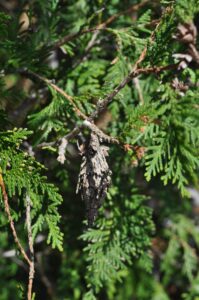Table of Contents
ToggleLast Updated on May 4, 2025
Have you ever noticed pine cone shaped or cocoon-like sacs on ornamental trees and shrubs in the spring and summer time? These are not normal pine cones that we see on evergreen plants in the winter time, instead they are a type of caterpillar that creates this ‘bag’ around it as it feeds on the host plants. Bagworms can cause substantial damage to ornamental trees and shrubs, which makes various treatment options important for homeowners with effected plants.
What do Bagworms look like?
Most notably known for the ‘bag’ the larvae make out of silk has an exterior of leaves or pieces of twigs from the host plant it is currently inhabits.

The larvae are dark brown with a yellow head and yellow and black spots on their bodies. While. the adult males look like moths that are a sooty black color, hairy and have almost clear wings that can span to one inch in diameter. The adult females, seldom seen, and are wingless, lack any functioning eyes, antennae, or legs. The adult females remain in the bag as they are not able to fly or move easily like the males.
Host Plants
Common to the New Jersey and East Coast, the bagworm can affect a large variety of trees and shrubs that are popular to this area. For example, some evergreen varieties of plants commonly affected by Bagworms include; arborvitae, juniper, cedar, fir, pine and spruce. These plants are largely popular among residential landscapes, making heavy infestation of Bagworms detrimental to landscapes in our area. Bagworms are found on other trees an shrubs such as rose bushes, maple, elm, black locust and sycamore.
Bagworm Damage
The primary damage caused by Bagworms is tree defoliation and brown spots. The bagworm larvae feed on the upper layer of leaves or needles on the ornamental trees and shrubs it is attached to. Heavy infestation of bag worms can leave plants looking completely defoliated and can eventually lead to severely damaged trees and even the death of the plant.
Bagworm Life Cycle
The spring time is when we first start to see bagworms hatch and immediately start to feed on the foliage of the host plant. In our area, bagworms really begin feeding on plants between May to early June. During this time, they also construct the bag like outer shell, and continues to feed on the plant only emerging from the bag a small amount when feeding.
In the summer time, the larvae stops feeding on the plant, and this occurs between late July to mid-August. This is when the larvae goes completely inside the bag, closing it up with a band of silk to enter the next stage of its life. This pupal state lasts around four weeks long, bringing the insect to the next season.
Starting in the fall, the bagworm males emerge from their bags as moth like insects. The male insect then flies around to find a female mate. The adult females remain in their bag and produce a pheromone to attack males. Once the insects mate, the female deposits between 500-1000 eggs in the bag and then both adult insects die after reproduction.
Through the winter, the eggs in the abandoned bag remain protected through the harsh weather months. In the spring, the eggs hatch and start the next generation of bagworms.
Bagworm Control and Treatment
There are a couple methods of control when dealing with bagworms; there is manual removal, natural predators, and chemical control. First, we can talk about manual removal. This method is only effective when you have detected the bagworms early; meaning late fall, through the winter, or before the larvae hatch in the spring. You can manually cut the bag from the ornamental tree with pruning shears. We recommend disposing of the bags in a separate bag and removing them off your property Manual removal is also only reasonable when a bagworm population is low.
Natural predators for bagworm control include certain bird species, insects and fungi. We do not recommend relying on natural controls when dealing with bagworm infestation on your ornamental trees and shrubs as damage is still likely to occur.
Finally, there is chemical control. For the treatment of bagworms, we recommend contacting your local ornamental tree service who can safely apply an insecticide in the spring once the larvae have emerged from their bag.
Conclusion
Bagworms can cause substantial damage to ornamental trees and shrubs on a property and we do not recommend ignoring their presence as they can lead to tree death. If you are in our service area and would like to receive an estimate for bagworm treatment, request an estimate today. Our licensed technicians have the knowledge to work with customers on creating a plan to treat the insect.

